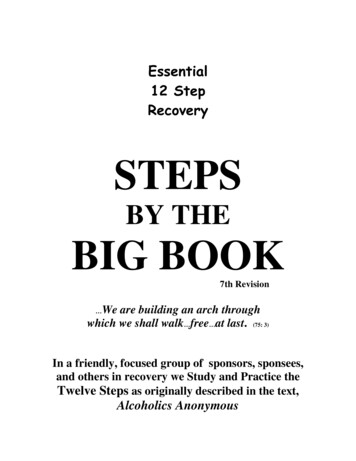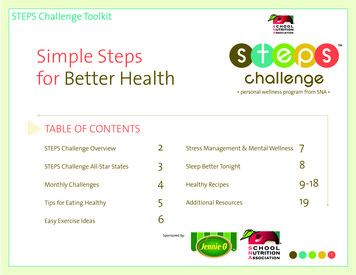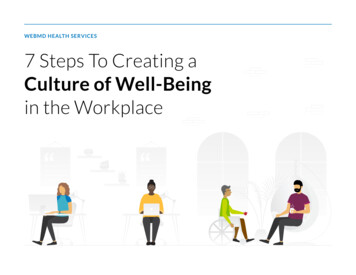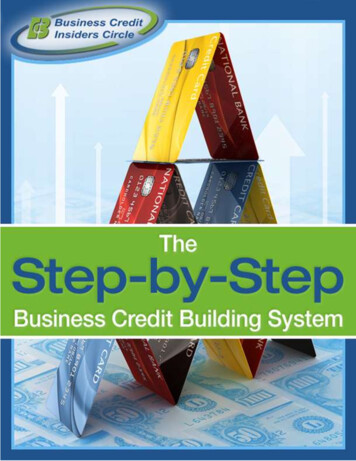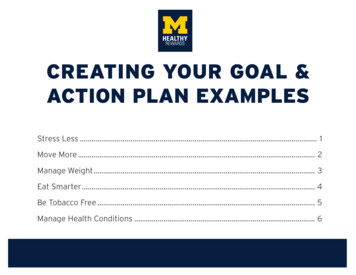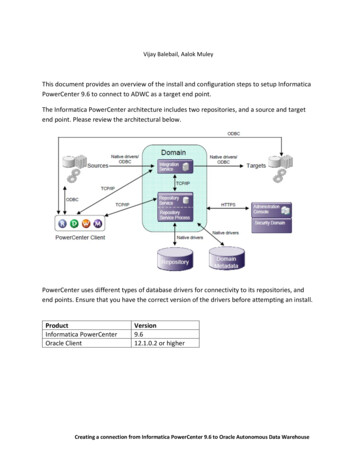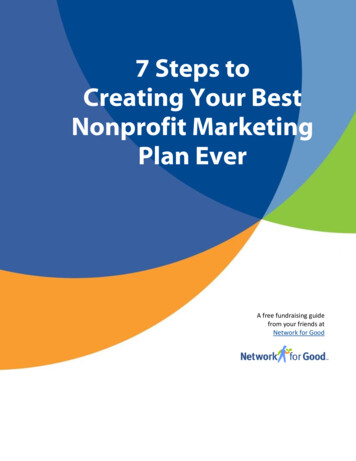
Transcription
7 Steps toCreating Your BestNonprofit MarketingPlan EverA free fundraising guidefrom your friends atNetwork for Good
Table of Contentsp. 4Perform an Organization Self-Assessment p. 7Set Goals and Strategy p. 9Determine online and offline tactics (donate button plus email outreach)Consider social networkingDefine Budget, Timeline, and Resources p. 17Understand me marketing vs. you marketingEngage (and inspire) your audienceCraft a call to actionChoose Your Tools p. 16Understand what differentiates your nonprofitFind your brand’s sweet spotCraft Your Message p. 15Set objectives and goalsOutline your strategy and tacticsDetermine Your Unique Value p. 11Determine your current audienceEvaluate current materials and toolsOutline your budget for each marketing activityCreate a marketing calendarAssign responsibilitiesTrack and Measure Your Results Understand the importance of trackingDevelop a timeline nowMeasure your progress SHARE THIS GUIDE:Network for Good7 Steps to Creating Your Best Nonprofit Marketing Plan Ever 2
A Word About Marketing Many nonprofit organizations struggle with the concept of marketing themselves andtheir missions. It seems too sales-centric, too fueled by money. They ask, "Is it slimy toapply marketing to nonprofits?" Our answer: Definitely not. Here's why: Marketing is a tool. Tools aren't good or evil. They are morally neutral methodsthat can be used for noble reasons or for ill. Marketing a good cause is a nobleendeavor. As people with a cause, we're in the business of persuasion. Marketing is a wayto be more convincing so that we're better at persuading people to buckle up,donate, sign a petition, eat healthily, or whatever the case may be. Marketingisn't "manipulation"; it's a way of doing what we already do, but better. Marketing is respectful. Refusing to take the audience's perspective into accountand talking to people as if you're shouting into a megaphone is not respectful.Asking people what they care about and then relating your cause to their values isrespectful. Good marketing is a conversation, and that's much less slimy than asoliloquy. Marketing is efficient. What is immoral and slimy is not doing good marketingand wasting precious taxpayer or donor dollars on ineffectively dealing with socialissues.The key is to be true to yourself. Marketing allows you to meet your audiences wherethey are, physically and mentally, but it does not require you to lose your own way. Staytrue to your mission, represent yourself honestly, and promise only what you candeliver. In that way, you can gain a competitive advantage over all the other folks usingmarketing for more nefarious ends.Get the most out of your nonprofit marketing efforts by having a well-organized andstrategic marketing plan. The seven steps in this guide will help you answer keyquestions, improve your messaging, and create your nonprofit marketing plan. SHARE THIS GUIDE:Network for Good7 Steps to Creating Your Best Nonprofit Marketing Plan Ever 3
1. Perform an Organization Self-AssessmentThe first step in any proactive marketing plan is to assess the current state ofmarketing at your organization. Take a step back and discover what’s actuallyoccurring—or not occurring—at your nonprofit.Define Your Audience(s)Let’s say that you run an animal shelter called Paws for the Cause. Your goal is to findloving homes for homeless cats and dogs in your area. Who is your audience here? Determine your constituents. Cats and dogs. Who else is there? Who comprisesyour donor base? Do you havevolunteers who regularly come in?Are there people you want to targetto adopt pets? What about localofficials you’re hoping will embracecertain policies? How did you meetthese people, and what are theygetting from you? Be honest. Create a list of everyoneyour organization comes into contactwith: people who visit the shelter,folks who have joined a newsletterlist from your website, people who have never heard of you but their friendshave, etc. This list will help you determine what you should be saying to them,as well as when and how. Think about how you treat your audiences. How do you treat your audienceswhen they call or email you? How often do you send fundraising appeals,information, updates, or policy alerts? What other types of communication areyou sending? What recognition do you offer donors for their generosity? SHARE THIS GUIDE:Network for Good7 Steps to Creating Your Best Nonprofit Marketing Plan Ever 4
Map Your MessagesNow that you have taken stock of who you are talking to, map out what you havebeen saying to them: What’s your tagline? Do you have mission and vision statements? What’s your elevator pitch? If you met someone in an elevator who had neverheard of your organization, how would you describe your impact during that30-second ride? Who wrote your messages? Was it a consultant, your executive director, acommunications intern who had snappy catchphrases?Next, determine how effective and consistent your messages have been. There aretwo quick ways to understand where your organization stands on this front: Ask two volunteers and two staff members, “What does our organization do?How are we different?” Ask a few of your supporters these same two questions.Hearing any varying opinions may be eye-opening. If everyone seems to be on thesame page, are they repeating what you (you fabulous marketer, you) think is yourorganization’s true identity?Define Your ChannelsWhich communication channels do you use and how often? Organizational websiteSocial media (Facebook, Twitter, blogs, and so on)Paid advertising (Google AdWords, print or online banner ads)Unpaid placements (PSAs)Communications (newsletter, e-newsletter, direct mail)Special eventsBrochuresAnnual report SHARE THIS GUIDE:Network for Good7 Steps to Creating Your Best Nonprofit Marketing Plan Ever 5
It’s Time for Analysis!As fun as gathering all of this data has been, it will not do you much good unless you putit to use. Now, you should evaluate the quality and effectiveness of your marketingoutreach. Some of your research may drive these discussions, but here are a few basicquestions to consider: Are your messages consistent? Are your communications materials how you want them to be? What wouldyou change? Does the way your organization perceives itself match the way others see it? Are your communications heavily weighted on fundraising versus other typesof outreach? Does your tagline differentiate you from other organizations that focus onsimilar issues? Were there any audiences you hadn’t considered or spoken to directly prior tothis fact-finding? SHARE THIS GUIDE:Network for Good7 Steps to Creating Your Best Nonprofit Marketing Plan Ever 6
2. Set Goals and StrategiesA properly organized nonprofit marketing plan supports itself like a pyramid. Foreach goal, there are objectives, every objective has strategies, and each strategy hastactics. However, all too often the terms goal, objective, strategy, and tactic are usedinterchangeably. Plainly put, they aren’t the same—and the resulting lack ofprecision can be problematic.GoalsA goal is a "statement of being" for a plan. While the completion of a goal signifiesthe end of your plan, the objectives, strategies, and tactics are the means to thatend.ObjectivesObjectives are more focused and specific. The best-formulated objectives expressresults as measurable outcomes. Think in terms of the awareness, attitude, or actionthat you hope to invoke. Often there are multiple objectives in support of a singlegoal. Meaningful objectives start with action verbs and have four parts. They should:1. Identify a specific audience being addressed.2. State a measurable outcome.3. Set an attainment level.4. Set a time frame.StrategiesStrategies are where the rubber meets the road. Rarely is one strategy enough tofully accomplish an objective. Likewise, it is not unusual for a single strategy to servemultiple objectives.TacticsTactics are the specific tools you use to implement your strategies. News releases,brochures, media pitches, e-newsletters, blogs, websites, surveys, focus groups, andvideos are some examples that spring to mind. It is up to you to decide exactly whichtactics are needed to successfully implement the chosen strategies.A good nonprofit marketing plan is interlinked from top to bottom. Without goodtactics, a strategy will not successfully complete an objective, rendering the successof a goal limited. A true marketing plan should employ the right mix of experience SHARE THIS GUIDE:Network for Good7 Steps to Creating Your Best Nonprofit Marketing Plan Ever 7
with critical thinking. With a strong understanding of the key differences betweengoals, objectives, strategies, and tactics, you’ll have a clear plan that can besuccessfully executed.What Do These Goals and Objectives Look Like?Let’s revisit our friends Paws for the Cause. With their new plans and goals in place, itis important for them to keep perspective about what these objectives set out to do:Paws for the Cause is planning ways to persuade audiences to take some sort ofaction.See the table below for examples of this “Point A to Point B” planning:Target AudiencesLocal pet storesDonorsCommunity members unfamiliarwith Paws for the CauseOnetime volunteersDesired ActionsOffer shelter dogs for adoption.Give financial support for the shelter’s newpuppy wing.Visit your website and sign up for yournewsletter.Become a regular volunteer.Now, think about your distinct audiences and which actions you would like them totake as a result of your outreach:Target AudiencesDesired Actions SHARE THIS GUIDE:Network for Good7 Steps to Creating Your Best Nonprofit Marketing Plan Ever 8
3. Determine Your Unique ValueWhat is the foundation of your fundraising messaging and nonprofit outreach? Yourpoint of differentiation. What makes your nonprofit the only one of its kind? Here’show to determine your nonprofit’s unique value proposition:1. Take a journalistic approach to determining your "onliness." Break it downwith five Ws and an H: Who (are your constituents), What (is your issue area),Where (are your constituents located), When (do they need you), Why (areyou important), and How (are you different)?2. Get an outside insider's opinion. Call a volunteer and ask why he or she isinvolved with your organization and not Joe's Other Advocacy Group down thestreet. Your view of your differentiator might be way off from what yoursupporters see.3. Complete this phrase: "Our nonprofit is the onlythat." Thisgets right to the core of why your organization exists in the first place. Who areyou serving that no one else does, and how are you doing it differently?Use your “onliness” statement to help you make decisions. Will a new program alignwith your statement? How can you position your organization in fundraisingcampaigns? SHARE THIS GUIDE:Network for Good7 Steps to Creating Your Best Nonprofit Marketing Plan Ever 9
Find Your Brand's Sweet SpotThink about what happens at the intersection of what's important to your audience,what your organization is good at, and what you're doing that nobody else is. SHARE THIS GUIDE:Network for Good7 Steps to Creating Your Best Nonprofit Marketing Plan Ever 10
4. Craft Your MessageNow you know where you’d like to go. How do you get there? Appeal to youraudience’s values.How to Put Your Audience FirstMany organizations create their marketing materials with the worst approach forgetting attention from the people they want to reach. They send their messages outwith what Jay Conrad Levinson calls "you marketing." You marketing: The kind of communication that centers on the organization.When I pick up your brochure as a prospect, I am learning about you. You aretalking about you. You are telling your side of the story. Me marketing: Most people are tuned into what matters to them. They careabout messages that speak to their needs. If I pick up your brochure and it istalking about me, I am far more interested. This approach forces you to findthe benefits of what you are offering to people.Look at your nonprofit’s website and brochures. Do you talk about your mission, yourgreat staff, your awards, your programs? Is it all about you, you, you? How can youchange the copy to reflect more "me marketing”?To refocus your nonprofit outreach, make sure your messages satisfy what wedescribe as CRAM: Connecting, Rewarding, Actionable, and Memorable:1. Connect to things your audience cares about. Saving time, feeling good aboutthemselves, feeling powerful, etc.2. Identify and offer a compelling reward for taking action. Remember thatgood rewards are immediate, personal, credible, and reflective of youraudience’s values.3. Have a clear call to action. Good actions are specific, feasible, and easy tovisualize doing. They should measurably advance your mission.4. Make it memorable. What makes something memorable? It's memorable ifit's different, catchy, personal, tangible, and desirable. These memorableelements should always be closely tied to your cause. SHARE THIS GUIDE:Network for Good7 Steps to Creating Your Best Nonprofit Marketing Plan Ever 11
Craft Your Call to Action—With Emphasis on ActionYour call to action is the pivotal piece of your message, so it’s important to get it right.An effective call to action has five necessary attributes. Let’s revisit our Paws for theCause example to see how they might carry through a call to action:1. Be highly specific. If Paws says to stop all animal abandonment, a personmight respond, “I can’t solve that entire problem.” Instead, focus on a veryspecific action, such as, “Forward this email to five of your friends toencourage them to learn more about pet drop-off options.”2. Be feasible. Your action needs to be very easy to do so that it doesn’toverwhelm potential supporters. When somebody does something small, theyare more likely to do something larger later on. It’s not appropriate to ask aone-time, 10 donor to donate 1,000 to your capital campaign—personalizeyour messaging.3. Have a first priority. Not everybody is ready to donate, volunteer, or clean upthe kitten cages at your shelter right this very second. Think about how youcan build your community of potential supporters and about enticing ways toget a person's email address.4. Be free of barriers. Watch somebody go through the steps involved in your callto action and see where they get hung up, if there are unnecessary steps, andif everything is easy to understand. Honor your audience's time by makingeverything as straightforward and quick as possible.5. Be filmable. Your audience needs to be able to visualize what they will bedoing. If they can't picture themselves doing it, they aren’t likely to do it. Forexample, it’s pretty easy to picture yourself forwarding an email or spending aSaturday morning with puppies. SHARE THIS GUIDE:Network for Good7 Steps to Creating Your Best Nonprofit Marketing Plan Ever 12
Engage Your AudiencesYour marketing messages need to put the recipient first and have four clearcharacteristics: connection, reward, call to action, and a memorable quality. At thispoint, you have an audience-centric message. Now you need to engage thataudience to pay attention to your message. Here’s a quick checklist of ways toengage your constituents with your messaging: Do cross-channel promotion. Email your donors before they receivepostal mail appeals. On the phone, give your donors the option to giveonline. Send email to your best offline donors. Make the pieces worktogether. Make marketing a conversation. Be sure that all your online outreachand presences enable two-way conversation with your supporters, fans,and nonfans. Be accessible, easy, encouraging, and intimate. Show accountability. Make it clear where the money goes! Make it easy for people to find you. Optimize your search enginemarketing. Start by getting as many high-quality links to your site aspossible. Segment your way to success. Talk with supporters differently dependingon who they are, how they give, and the ways in which they support you. Test, test, test. Try never to do one version of any appeal or newsletter.Test different versions so you can learn and improve all the time. Make your supporters your messengers. Ask your supporters to spreadthe word among their friends and family. SHARE THIS GUIDE:Network for Good7 Steps to Creating Your Best Nonprofit Marketing Plan Ever 13
Do More Than Engage—InspireWhether you’re after supporter dollars or volunteer engagement, inspiration is thedriving force behind taking action.Here are a few quick, actionable tips for building passion for your organization:1. Tell your organization’s founding story once a year. Communications guruAndy Goodman calls this part of the “sacred bundle” of stories—a profoundreminder of the deep values and moral struggle that gave rise to yourorganization’s existence.2. Have a cultivation strategy and calendar. Send emails to donors that thankthem and report back on how you’ve spent their money.3. Ask your donors for their feedback and opinions on a regular basis. And usetheir advice when appropriate; it shows that you’re listening.4. Offer periodic live chats or phone-in briefings with your CEO. This is a stapleof major donor fundraising, inexplicably absent from the online giving scene.5. Offer real-life glimpses into the life of your organization. Your supportersexpect authenticity, which is arguably the paramount value in marketingcommunications.(Source: SeaChange Strategies and Care2, A Procrastinator’s Guide to Year-End Fundraising) SHARE THIS GUIDE:Network for Good7 Steps to Creating Your Best Nonprofit Marketing Plan Ever 14
5. Choose Your ToolsWe’re all about nonprofits becoming online fundraising and marketing superheroes.And every superhero (even the planner types, like you) needs a utility belt ofresources to get through the day-to-day tasks and the tight spots you might run intoalong the way.Determine Your Online and Offline Marketing MixThere is no single recipe for success when it comes to determining a nonprofitmarketing mix. It will depend on what makes the most sense for your audiences,including constituents, donors, volunteers, and advocates.Use this checklist to determine what makes the most sense for your organization:Online Website Social media (Facebook, YouTube, Twitter)Tip: To stay audience- Paid advertising (banner ads, Google AdWords)centric while you developyour marketing mix,gather information aboutyour audience’scommunicationpreferences. You mightthink most of yoursupporters are strictlyoffline (or exclusivelyonline). Don't assume—get to know them! Public relations placements on websites/blogs Special events pages Online donation page Email outreach (e-newsletter, advocacy alerts,fundraising appeals)Offline Printed collateral (brochures, annual reports) Direct mail Newsletter Paid advertising (outdoor, print) Public relations placements (radio, TV, newspapers, magazines) Phone bank Special events SHARE THIS GUIDE:Network for Good7 Steps to Creating Your Best Nonprofit Marketing Plan Ever 15
6. Define Your Budget, Timeline, and ResourcesSet Your BudgetNow that you’ve determined the right mix of channels for your outreach, decide howmuch money you’ll need for producing your marketing materials, email and offlineoutreach expenses, as well as paid media such as advertising or search enginemarketing (e.g., Google AdWords). You can choose to track your budget by quarter orby month depending on the level of detail you need.Q1Q2Q3Q4WebsiteEmail Marketing 500 200 500 250 750 200 500 400AdvertisingPrint Materials 300 500 300 500 300 500 300 1,000Create a Marketing CalendarA marketing calendar is one of the best ways to coordinate your marketing efforts.Your calendar should include all of the action items needed to successfully executeyour marketing plan. Start by listing your major marketing tent poles (such as awebsite redesign, fundraising campaigns, and events), and then fill in all of the tasksyou must accomplish to make them happen. Include any regularly occurring outreach,such as newsletters or member updates. You may wish to organize your calendar byaudience, channel, or specific et HealthMonthYear-endgiving updateDog DaysadoptioneventDog Daysevent iersWebsitelaunch &contestKUSA LocalStoriesInterviewPet HealthtipsDonor &volunteerthanksAdoptiongallery in PostPet overYear-endfundraising updateDonation andsupply drivepostersAssign RolesClearly outline who will be responsible for each action item. Think about your tacticsand plan who on your team will be responsible for managing and completing eachitem. SHARE THIS GUIDE:Network for Good7 Steps to Creating Your Best Nonprofit Marketing Plan Ever 16
7. Measure and Track Your ResultsA marketing plan that sits on the shelf is not particularly useful. You should regularlyreview your results to verify that your goals have been met or to determine if newstrategies are in order. To round out your marketing plan, include the following: Timeline: How often will review your plans—monthly, quarterly, semiannually,annually? Metrics: How will you measure your success? Consider website analytics, enewsletter subscriptions, and number of volunteers signed up. These metricswill be defined by what you want to accomplish. (Paws for the Cause mightmeasure adoption rates, advertising impressions in Pets Weekly magazine,number of shelter volunteers, and so on.) Evaluation: Remember the primary research we accomplished in Step 1:Perform an Organization Self-Assessment? Revisit those audiences and seehow your marketing activities have changed and/or improved yourorganization’s situation.Turn Your Assessment into a New PlanAs you determine how well your marketing initiatives are paying off, remember thatthis process is cyclical. Nonprofit technology expert Beth Kanter suggests these stepsfor turning metrics into action:Step 1: Identify the goal or improvement. Paws for the Cause wants to increaseadoption rates by 10% in the next 6 months.Step 2: Identify the single most important metric. Number of adoptions.Step 3: Explore it. How easy have we made it to get involved? What informationhave we provided to prospective owners? What resources do we givethroughout the adoption process? If I call the shelter information number,will I receive helpful service?Step 4: Ask, “What if I did ?” What changes can you make? What holes did youfind in your research? Could Paws use a new information request form onits website?Step 5: Measure. What have the results been now that we’ve implementedchanges and upgrades to the process of adoption and recruiting new petparents? SHARE THIS GUIDE:Network for Good7 Steps to Creating Your Best Nonprofit Marketing Plan Ever 17
RememberBe true to yourself and your audience!Analyze your past outreach to discover who truly makes up your distinctaudiences.Celebrate your uniqueness by sharing your point of differentiation with your fans.Appeal to your audience’s values with messages that are connecting, rewarding,actionable, and memorable.Don’t just engage with your fans—inspire them!Measure your messaging to achieve your goals and tweak your strategies.Learn MoreHow to Make the Case for GivingUse these eight steps as a guide to help your organization craft a compelling case forgiving. Packed with fundraising tips, this free guide will help you connect with donorsand raise more money.Download this free guide now.Nonprofit Guide to Email EngagementDo your donors only hear from you when you’re asking for money? It’s time to revampyour engagement strategy. Learn how to craft an amazing welcome series and continueto inspire your supporters through email.Download this free guide now. SHARE THIS GUIDE:Network for Good7 Steps to Creating Your Best Nonprofit Marketing Plan Ever 18
About UsNetwork for Good powers more digital giving than any other platform. Since 2001, we’ve processedover 875 million for more than 100,000 nonprofits. We are Level 1 Audited PCI Compliant andaccredited by the Better Business Bureau Wise Giving Alliance, meeting all 20 of its standards forcharity accountability. Plus, we’re registered in every state for online fundraising.We’re a mission-minded organization, just like you, so we understand the challenges you face. We’rehere to help.Our suite of affordable fundraising solutions helps nonprofits raise money and engage supportersonline—plus we provide the training that will make you a fundraising superstar.1. Get an easy-to-use, branded, and secure online donation page with DonateNow. With built-inbest practices and mobile-friendly giving options, you’ll raise more than ever before.2. Email campaign and newsletter tools by Constant Contact for sending and tracking emails andtelling you which messages work best.3. Fundraising Fundamentals premium training: Exclusive access to Network for Good’s expertadvice with personalized reviews, step-by-step tutorials, fundraising templates, and more.4. Online event management: EventsNow, powered by givezooks!, for accepting donations,registrations, and ticket purchases online.Free Fundraising TipsSee a DemoLet Us HelpGet weekly fundraising advicedelivered right to your inbox.Learn more about howDonateNow can help youreach your fundraising goals.Find out how you canattract more donors andraise more money online. SHARE THIS GUIDE:Network for Good7 Steps to Creating Your Best Nonprofit Marketing Plan Ever 19
7 Steps to Creating Your Best Nonprofit Marketing Plan Ever 7 SHARE THIS GUIDE: 2. Set Goals and Strategies A properly organized nonprofit marketing plan supports itself like a pyramid. For each goal, there are objectives, every


